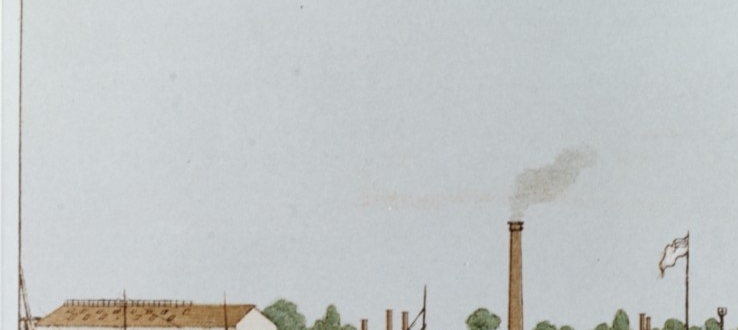
Overall Views 19th Century
By the time of the Civil War, the Washington Navy Yard was well into its change to a heavy industrial facility. After the steam frigate Minnesota, launched in December 1855 and completed in May 1857, only one more significant ship would be fully constructed there, the gunboat Nipsic during 1873-79. The Navy Yard built and installed machinery for several ships during the 1860s, and continued to do ship repairs long after that, but its efforts were increasingly concentrated on ordnance manufacture and testing.
Though the waterfront area was still dominated by two big wooden ship houses, one oriented roughly east-west near the western end of the yard, and the other running north-south at the eastern end, many new buildings were erected to support ordnance manufacturing. Among these was an ornate foundry to the north of the western shiphouse, and nearby, the large brick "quadrangle", measuring some 300 feet wide by 400 feet long. The latter is still in use and looks much as it did in the 1860s, though its interior and its purposes have been greatly changed.
Just inland from the waterfront, and east of the western shiphouse, a long shed-like structure was built to serve as an experimental gun battery. From it, guns could be fired down the Anacostia River, where points of impact could be precisely observed, allowing scientific testing of guns, gun propellants and projectiles at the ranges typical of Naval weapons in the muzzle-loading age.
Immediately south of the Commandant's Office, a house-like structure about in the middle of the yard's waterfront side, a semi-circular park was established to hold captured guns. Most of these weapons, trophies of the conflict with the Confederacy, remain on exhibition at the Navy Yard in the Twenty-First Century.
Also in front of the Commandant's Office, but closer to the river, a large pile of coal was much in evidence, fuel for ships and for the furnaces and steam boilers of the yard's industries. Among the factory buildings, tall smokestacks further attested to coal's importance to "iron-age" industry.
This page features 19th Century overall views of the Washington Navy Yard, and provides links to similar images of later date.


